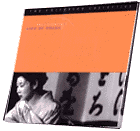

Japan drama
1952
bw 137 min.
Director: Kenji Mizoguchi
CLV: $69.95 - available
2 discs, catalog # CC1481L
VHS: available from Home Vision Cinema
Of all the trademarks of Kenji Mizoguchi's films, the most powerful and insistent is his outcry against the brutalization of women by Japanese society. Of his films decrying women's enslavement, Life of Oharu is his masterpiece. Set during the Genroku period of the late 17th century, it depicts with serene relentlessness the grinding down of a woman into prostitution and destitution by a male feudal society. Mizoguchi often said that the distancing effects of time‹and his aesthetic style‹were not intended to let contemporary Japan off the hook. Past or present, he said, Japanese women were always treated like slaves.
The film is told in flashback. Kinuyo Tanaka's Oharu, an ill-used woman of 50, treated kindly only by her fellow prostitutes, visits a Buddhist temple and sees in the visage of a statue the superimposed and idealized face of her lower-class lover (Toshiru Mifune), whose ardor began her troubles. A lady of the imperial court, she's haughty, then moved by this young page, who woos her sincerely but disastrously. Individualism, making one's own choice about marriage, was unheard of in feudal Japan, where it was regarded as an intolerable threat to the rigid social order. Because Oharu dares to aspire to love, she and her parents are exiled.
She finds little sympathy from the paternalistic social structure, personified by her father. He berates her, selling her to a clan that requires a surrogate mother. He sells her yet again when she returns home with a pittance after giving birth; the barren lady of the house had been threatened by her presence. Mizoguchi keeps Oharu rebellious‹or as rebellious as she can be without being severely punished. Powerless, Oharu continues to be victimized, then vilified. A stint as servant to a merchant is ended by another jealous wife. Mizoguchi was not blind to the way women were set against each other.
The merchant's hypocrisy‹forcing himself on Oharu when he says he's at prayers‹is one of several Mizoguchi jabs at religion. Near the end, Oharu is hired by an old pilgrim, only to be humiliated further. Dragging her to a band of acolytes, he offers her as an example of the pitfalls of sex, and denounces her as a witch. To the end, the pattern holds. Reduced to begging, she's given something by a mother with a baby, then has a door slammed in her face by a man. Finally, her retreat within herself complete, she wanders out of the frame, leaving only a background shot of a pagoda, as if Mizoguchi is asking it and the social class it emblemizes to answer for Oharu's misery--or be revealed as the reason for it.
Women are stronger than men in Mizoguchi's films. Partly it's because suffering strengthens them. It's the injustice of the suffering to which Mizoguchi kept returning in a long string of films ranging from Osaka Elegy to Street of Shame. In film after film, Mizoguchi conveyed social and emotional tempests boiling beneath immaculately formal surfaces. His controlled camera heightened his protagonists' inner turmoil‹and his own reformist zeal. At the end, Tanaka's face, gaze fixed beyond the boundary of the frame as if peering toward the next world after abandoning any promise of comfort in this one, is the perfect vehicle for bleak stoicism, scoured of aspiration, clawing at dignity through survival alone.
-- Jay Carr
Jay Carr is the film critic for the Boston Globe.




